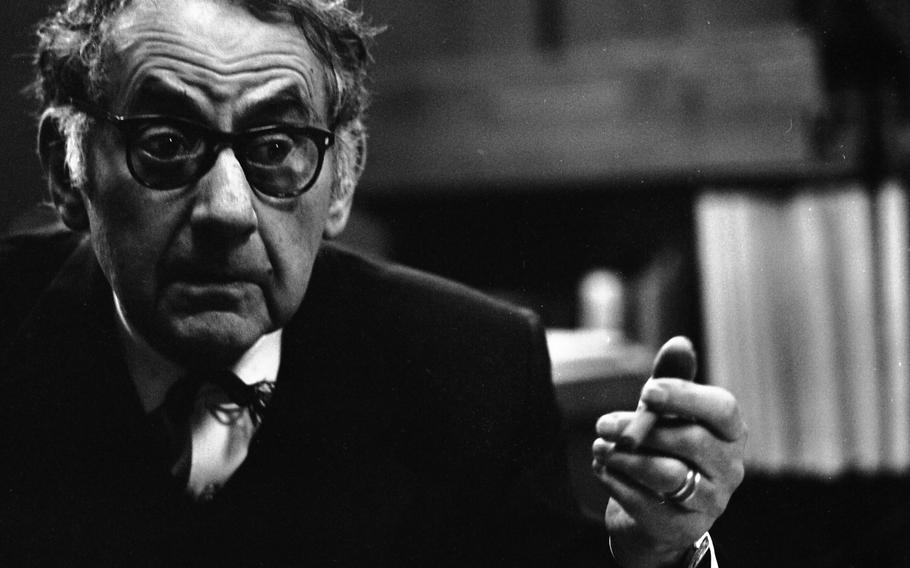
Artist Man Ray, photographed in his Paris studio, during an interview with Stars and Stripes reporter James Gunter. (Ted Rohde/Stars and Stripes)
This article first appeared in the Stars and Stripes Europe edition, Jan. 14, 1966. It is republished unedited in its original form.
Man Ray sat chain-smoking cigarettes in a big Paris studio crammed with his circus works and shook his curly gray head about the state of the art in the world. He thinks it fails to do anything new.
“Everything I see seems to come from something we did 40 years ago,” he said.
“We” means the Dadaists, a cult of deliberate irrationality that sprang up in Europe during the First World War. Man Ray, one of the movement’s main forces, says its hostility to bourgeois art and conventions led directly to surrealism and other 20th century revolts in art and letters, including Pop.
“Pop is a revival of the spirit of Dada,” he said. “I’d like to see something I don’t understand – something that mystifies me.”
Tossing ideas right and left, the Philadelphia-born artist settled down on a big sofa. Nearby in the studio at 2 bis Rue Ferou, sat his wife, Julliet.
“Picasso, Matisse and Braque. I like them as personalities,” he said. “Their work doesn’t inspire me, but their energy and productivity give me inspiration.”
“I avoid labels. I believe in personalities, which is rather difficult nowadays.”
“I’m not a politician. I don’t need a majority. I don’t want notoriety. I’m supposed to be modest, but it amuses me to push my paintings.”
He is perhaps even more renowned for his innovations in photography than for his paintings, but he spends most of his work time these days painting, and there has been a recent flurry of interest in his work. He has just opened an exhibit in New York, will have another in Los Angeles in June, and there have been recent retrospective shows of his vast output in many countries.
“The modern school was not accepted when I exhibited in New York before,” he said. “Now they accept everything.”
He said his life’s statement is wrapped up in 40 or 50 exhibits.
“The last couple of times I exhibited in New York I was severely criticized. Now they are adding my work to collections.”
He still feels a “form of suspense” as he creates a painting. “As soon as I have finished, it is like having a good meal or a nice love affair,” he said.
Now 75, he admits he can no longer work as before.
“I want to be comfortable and not too busy,” he said. “What am I striving for? I pursue liberty and pursue pleasure. We all live that way but we won’t admit it.”
“I want the freedom to do everything that comes into my mind, even if it contradicts myself.”
He once went outside his studio, where he has lived for the past 14 years, and executed a straightforward watercolor painting of the street.
“I did it because I am not supposed to,” he said. “I know abstract painters who would love to do a thing like that, but they don’t dare.”
Man Ray lived in Paris before Word War II, but went to California in 1940 after the Germans arrived. He returned in 1950 from Hollywood.
“It’s immaterial where I am,” he said. “My world is so different. One reason I stayed in France was to eat and drink, but I have been on a regime, eating simple food because of my rheumatism.”
“I drank a lot before and stayed out until 5 in the morning, but now I live within my walls, Sometimes I forget where I am, I wake up in the morning and I don’t know where I am.”
Man Ray came to Paris after World War I to find Dadaism in full swing. He said he met with musicians and writers in Paris cafes to discuss the movement which at first was purely literary. Soon he was turning out Dada art and arranged his first exhibit.
“I never considered myself a surrealist, but I took a parallel course,” he said.
The artist, who looked very neat in a blue jacket and string tie, said he got into photography with the idea of photographing his works, showing off his paintings and objects “the way I want them to appear.” Later, he did studio shots, including work for fashion magazines.
An outgrowth of Ray’s photographic career was his rayograms in which he arranged objects on sensitive paper in the darkroom and then shined a light on them to reinforce the outlined objects with unexpected designs.
“I was doing that in 1931,” he said.
A cabinet in his studio contains thousands of drawings and ideas.
“I started as an architect,” he said. “I can build houses or design clothes.”
“I developed a color process in photography and would like to do more with it, but it is too late. I am too tired.”
“I paint what I cannot photograph.”
His studio contains such striking items as an arrangement of 63 coat hangers which he calls “an obstruction, not a mobile.” Nevertheless, according to the art history books, it was one of the first mobiles.
“There is little new,” he said. “The wheel with an axle is the only contribution that man has made to the world which doesn’t exist in nature. That’s really the only thing we have ever done.”